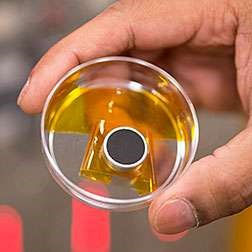Ball Horticultural Company

Salvia Mystic Spires Blue
The Department of Energy’s collaboration with Ball Horticultural Company in West Chicago, Illinois proves that good things can come in small packages. Leveraging the equipment and expertise at DOE’s Neutron Irradiation Facility, Ball has been able to develop and commercialize new ornamental plants that may very well be in your garden! Commercial successes include several New Guinea impatiens vegetative cultivars.
Of particular importance is Salvia Mystic Spires Blue, a compact salvia that is well-suited to landscapes and mixed containers. Salvia Mystic Spires Blue received US Patent PP 18,054 on September 18, 2007. Today, Salvia Mystic Spires Blue is available to growers in the U.S., Canada, Europe, Japan, and Australia.
Federal funding through the Department of Energy was used to build the accelerator facilities in support of its high energy physics missions. Operating funds for the Neutron Irradiation Facility have been provided by other institutions, most recently Northern Illinois University. This project was funded entirely by the industrial partner through an SPP Agreement.
RadiaBeam Technologies

Nanocathode
Scientists are a step closer to building an intense electron beam source without a laser. Using DOE’s High-Brightness Electron Source Lab, a team led by scientist Luigi Faillace of RadiaBeam Technologies is testing a carbon nanotube cathode—about the size of a nickel—that completely eliminates the need for a room-sized laser system. Tests with the nanotube cathode have produced beam currents a thousand to a million times greater than the one generated with a large, pricey laser system.
The technology has extensive applications in medical equipment and national security, since an electron beam is a critical component in generating X-rays. While carbon nanotube cathodes have been studied extensively in academia, Fermilab is the first facility to test the technology within a full-scale setting.
Fermilab was sought out to test the experimental cathode because of its capability and expertise for handling intense electron beams, one of relatively few labs that can support this project. A U.S. Department of Energy Small Business Innovation Research grant funds the RadiaBeam-Fermilab collaboration.
The new cathode appears at first glance like a smooth black button, but at the nanoscale it resembles, in Piot’s words, “millions of lightning rods.” When a strong electric field is applied, it pulls streams of electrons off the surface of the cathode, creating the electron beam. The exceptional strength of carbon nanotubes prevents the cathode from being destroyed. Traditionally, accelerator scientists use lasers to strike cathodes in order to eject electrons through photoemission. The electric and magnetic fields of the particle accelerator then organize the electrons into a beam. The tested nanotube cathode requires no laser: it only needs the electric field already generated by an accelerator to siphon the electrons off, a process dubbed field emission.
